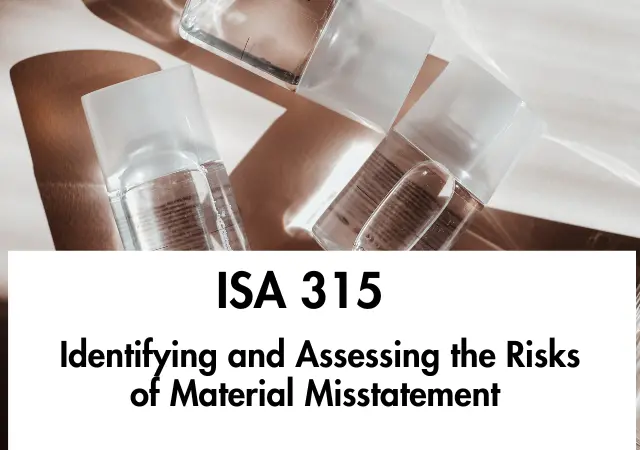ISA 315 (Revised) DEALS with the auditor’s responsibility to identify and assess the risks of Material Misstatement in the ‘Financial Statements’, through understanding the Entity and its Environment, INCLUDING the entity’s internal control.
Table of Contents
- ISA 315 (Revised) – Introduction
- ISA 315 – Objective
- ISA 315 – Definitions
- ISA 315 – Requirements
- Synopsis
ISA 315 (Revised) – Introduction
1. Scope of this ISA
It deals with the auditor’s responsibility to IDENTIFY and ASSESS the risks of Material Misstatement in the ‘Financial Statements‘.
2. Effective Date
This ISA is EFFECTIVE for audits of financial statements for periods ending on or after December 15, 2013.

ISA 315 – Objective
The Objective is to IDENTIFY and ASSESS the risks of Material Misstatement whether due to fraud or error at the ‘Financial Statement’ and assertion levels.
ISA 315 – Definitions
1. Assertions
Representations by Management EXPLICIT or otherwise that are embodied in the ‘Financial Statements‘.
2. Risk Assessment Procedures
The Audit Procedures performed to obtain an understanding of the entity and its environment, INCLUDING the entity’s internal control.
3. Significant Risk
An identified and assessed risk of Material Misstatement that in the auditor’s Judgment Requires SPECIAL audit consideration.
ISA 315 – Requirements
1. Risk Assessment and Related Activities
The auditor shall PERFORM ‘Risk Assessment Procedures’ to provide a basis for the identification and assessment of risks of Material Misstatement.
| Risk Assessment Procedures Include the Following: |
|---|
| (a) Inquiries of Management, of appropriate Individuals within the internal audit function and of Others within the entity; |
| (b) Analytical procedures; AND |
| (c) Observation and inspection. |
The auditor shall CONSIDER whether information obtained from the auditor’s client acceptance or continuance process is relevant to identifying risks of Material Misstatement.
2. The Required Understanding of the Entity and Its Environment, Including the Entity’s Internal Control
2.1 The Entity and Its Environment
The ‘Auditor’ shall OBTAIN an understanding of the following:
| (a) Relevant industry, regulatory and other external factors including the applicable financial reporting framework. |
| (b) The nature of the entity, Including: – Its operations; – Its ownership and governance structures; – The types of investments that the entity is Making and plan to make; AND – The way that the entity is structured and how it is financed. |
| (c) The entity’s selection and application of accounting policies. |
| (d) The entity’s objectives and strategies. |
| (e) The Measurement and review of the entity’s financial performance. |
2.2 The Entity’s Internal Control
The auditor shall OBTAIN an understanding of internal control relevant to the audit.
It is a Matter of the auditor’s PROFESSIONAL JUDGMENT whether a control, individually or in combination with others is relevant to the audit.
3. Identifying and Assessing the Risks of Material Misstatement
The ‘Auditor’ shall IDENTIFY and ASSESS the risks of Material Misstatement at:
- The financial statement level; AND
- The assertion level for classes of transactions, account balances and disclosures.
to provide a basis for designing and performing further audit procedures.
3.1 Risks that Require Special Audit Consideration
In exercising judgment as to which risks are ‘significant risks‘, the auditor shall CONSIDER at least the following:
| (a) Whether the risk is a risk of fraud; |
| (b) Whether the risk is relevant to recent significant economic, accounting or other developments; |
| (c) The complexity of transactions; |
| (d) Whether the risk involves significant transactions with related parties; |
| (e) The degree of subjectivity in the Measurement of financial information related to risk; AND |
| (f) Whether the risk involves significant transactions that are outside the Normal course of business. |
3.2 Risks for Which Substantive Procedures Alone Do Not Provide Sufficient Appropriate Audit Evidence
In such cases, the entity’s controls over such risks are relevant to the audit and the auditor shall OBTAIN an understanding of them.
3.3 Revision of Risk Assessment
The auditor’s assessment of the risks of Material Misstatement at the assertion level May change as additional audit evidence is obtained.
The auditor shall REVISE the assessment and MODIFY the further planned audit procedures accordingly.
4. Documentation
The ‘Auditor’ shall INCLUDE in the audit documentation:
- The discussion among the engagement team;
- Key elements of the understanding obtained regarding each of the aspects of the entity and its environment;
- The identified and assessed risks of Material Misstatement; AND
- The risks identified and related controls about which the auditor has obtained an understanding.
Synopsis
ISA 315 ‘Identifying and Assessing the Risks of Material Misstatement through Understanding the Entity and Its Environment‘ DEALS with the auditor’s responsibility to identify and assess the risks of Material Misstatement in the ‘Financial Statements’.
[300-499] Risk Assessment and Response to Assessed Risk
Chartered Accountant (Institute of Chartered Accountants of Pakistan)
Bachelor of Accounting Honours (Asia e University, Malaysia)